Previous Subchapter → 4.1 Introduction and Definitions
Which brings us to the Azov Battalion. When we talked about Azov in the Ukraine Narratives documentary we described them a Neo-Nazi military unit which emerged in 2014, at the start of the Donbas War between Ukraine and the Pro-Russian separatists, and that’s true, but they have a lineage that actually goes back a lot further.
Azov started as the offspring of another organisation called “Patriot of Ukraine”, which had its origins as a wing of a political party called the “Social-National Party of Ukraine”, which was formed shortly after Ukraine regained independence in the 1990s.
In the early 2000s the Social-National Party split into 2 movements “Svoboda”, a party led by Oleh Tyagnibok, which was still a far-right party but denied having ties to Fascism or Nazism, and the “Social-National Assembly” led by Andriy Biletsky, which maintained its clearly Nazi leanings.
In fact, we found an archived copy of the Assembly’s manifesto and when you read it, it sounds like something Hitler could sue for plagiarism over, with its pillars including promoting racism and ties to ancient aryanism, opposing democracy, and calling for the formation of an expansionist “Third Empire”.
When the Social-Nationalists split, “Patriot of Ukraine” went with the Assembly, and when the separatist conflict broke out in 2014 it was Biletsky and Patriot of Ukraine that formed a paramilitary group known as the “Black Corps”, which later became the Azov Battalion after joining a Ukrainian law enforcement agency called the “Special Tasks Patrol Police”.
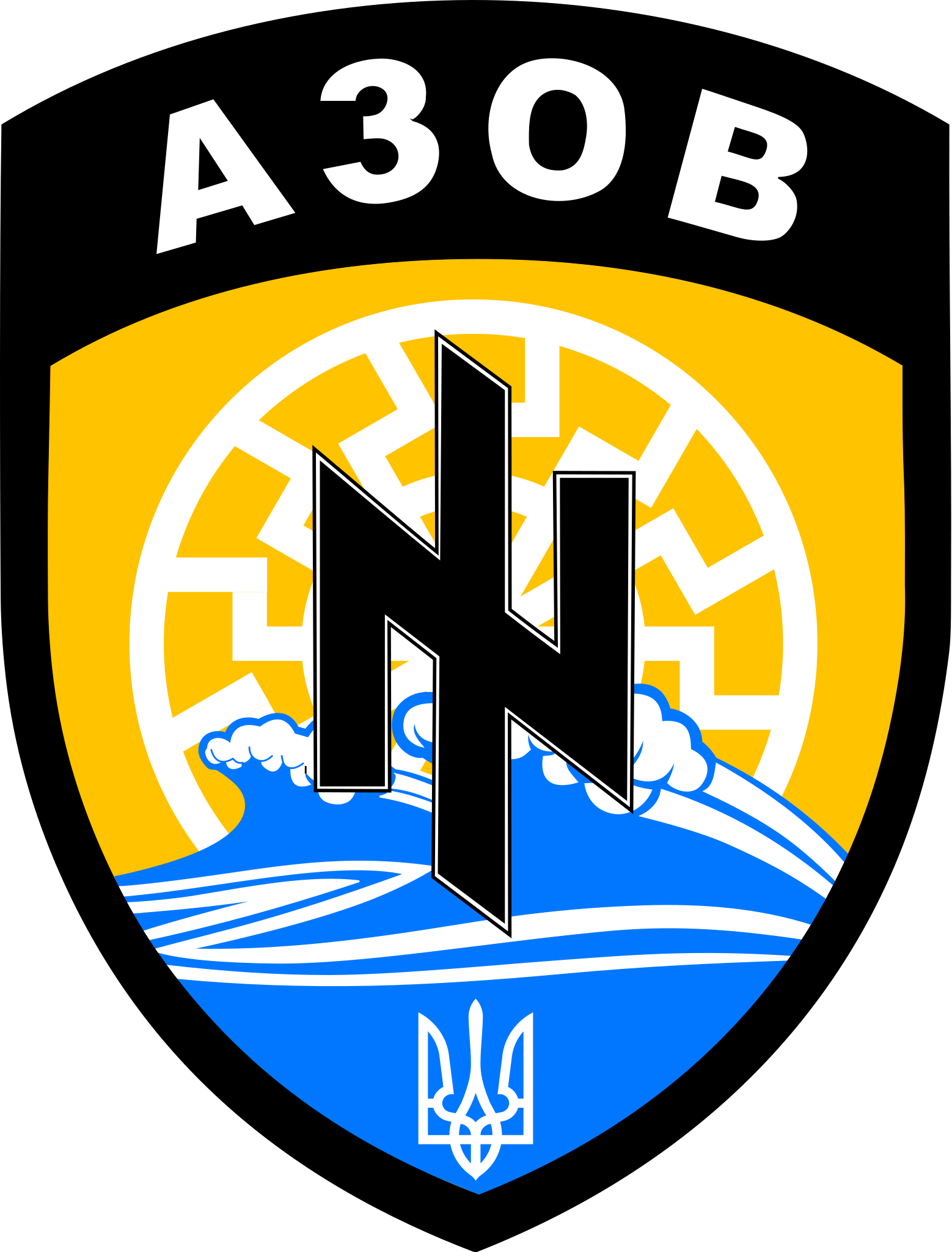 Azov were happy to display their Nazi lineage on their sleeves, adopting a logo that combined the Patriot of Ukraine logo, a variant of the Wolfsangel symbol commonly used by the SS, with the Black Sun, a Neo-Nazi symbol first found in SS leader Heinrich Himmler’s castle.
Azov were happy to display their Nazi lineage on their sleeves, adopting a logo that combined the Patriot of Ukraine logo, a variant of the Wolfsangel symbol commonly used by the SS, with the Black Sun, a Neo-Nazi symbol first found in SS leader Heinrich Himmler’s castle.
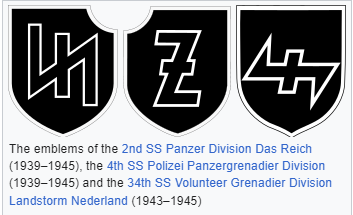 https://en.wikipedia.org/wiki/Wolfsangel#As_a_Nazi_symbol
https://en.wikipedia.org/wiki/Wolfsangel#As_a_Nazi_symbol
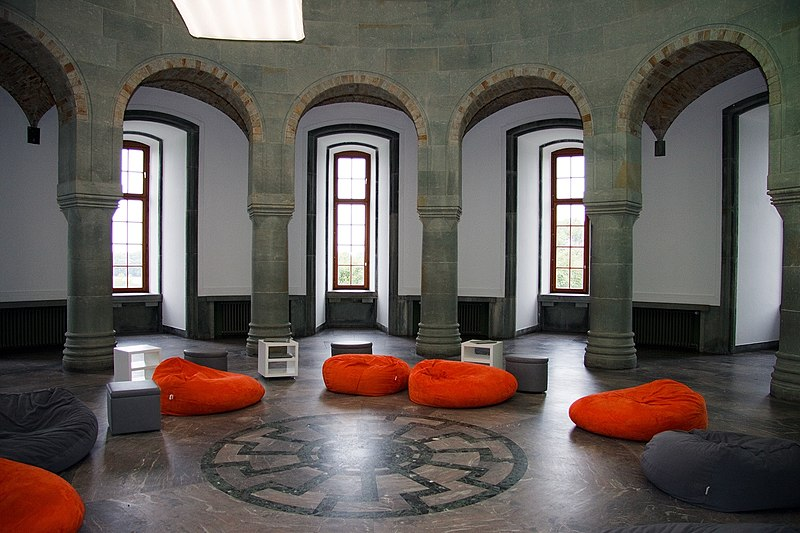 Attribution: Dirk Vorderstraße Licence: CC-BY 2.0
Attribution: Dirk Vorderstraße Licence: CC-BY 2.0
Now it’s worth noting that officially Azov has always denied that these symbols were based on Nazism, with Biletsky claiming that the Wolfsangel logo was a purely Ukrainian symbol and encouraging the media to not pay attention to the “imagination” of those trying to give secret meanings to it, but these denials are paper thin at best.
Again, you can just take a look at the manifesto, a manifesto Biletsky wrote by the way, which shows very clearly that these organisations were borrowing ideas from Nazi Germany.
And if that doesn’t convince you, we can compare the “National Idea” to interpretations of the Wolfsangel and see the similarities, take for example this Wolfsangel variant used by a US-based Neo-Nazi group called the “Aryan Nations”.
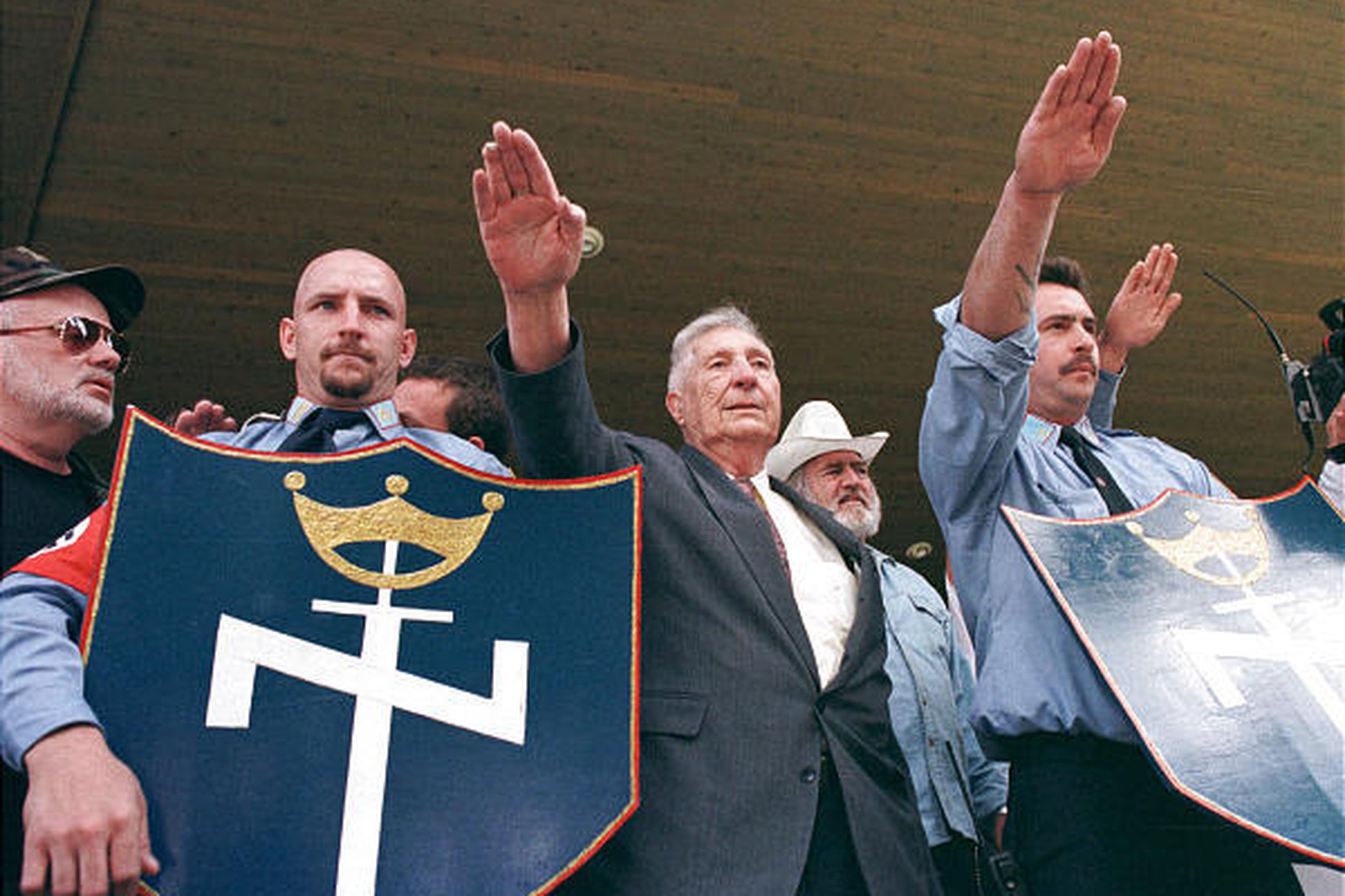
But since Azov is still active to this day, there are still attempts to normalise their symbols, for example we looked at this video which claims that any attempts to connect the “National Idea” to the Wolfsangel are simply “Russian propaganda”, as proof of the symbol’s apparent “ancient history” the video showcased an image that claims to be of a variant of the “National Idea” being used by a judge in 1601.
`But when we searched for this image using a Google Images search, we only found 2 results for it, the first is on a page about Azov called “Support AZOV” and the second is another far-right nationalist page, which traces the modern use of the symbol back to the Social-National Party and says it should represent an “uncompromising struggle” against “foreign nomads”.
Another instance of denialism we found regarding the Wolfsangel comes from Oleksii Rains, founder of a think tank known as the “Ukrainian Struggle Center”, which has also tried to claim that reports of the National Idea being connected to Nazism are simply Russian propaganda, however, when the outlet posted a thread from Rains on the topic, he admitted that the symbol’s use emerged with the Social-Nationalist movement, he then tried to prove that the National Idea symbol had become a widespread symbol used broadly by Ukrainian patriots, and then the only examples he could provide were organisations linked to the “Social-Nationalists”.
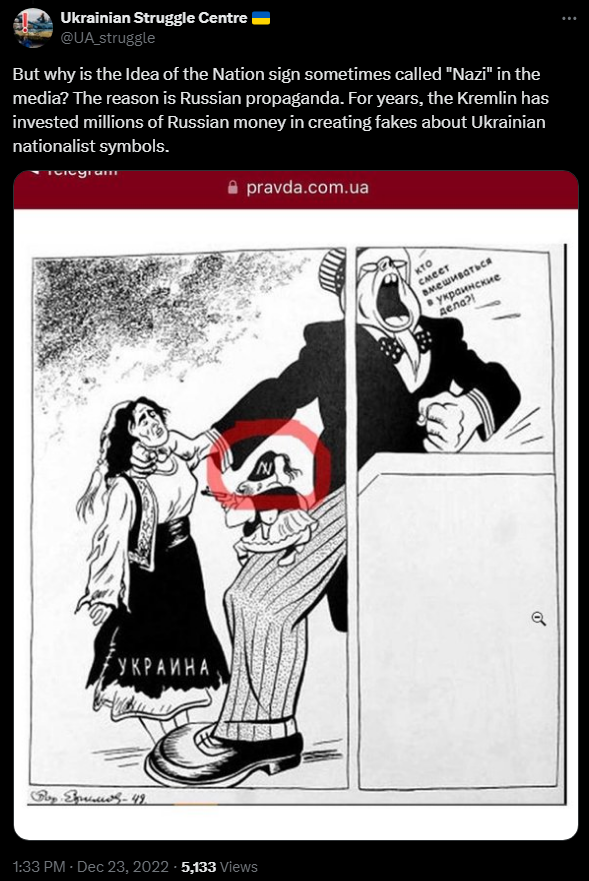
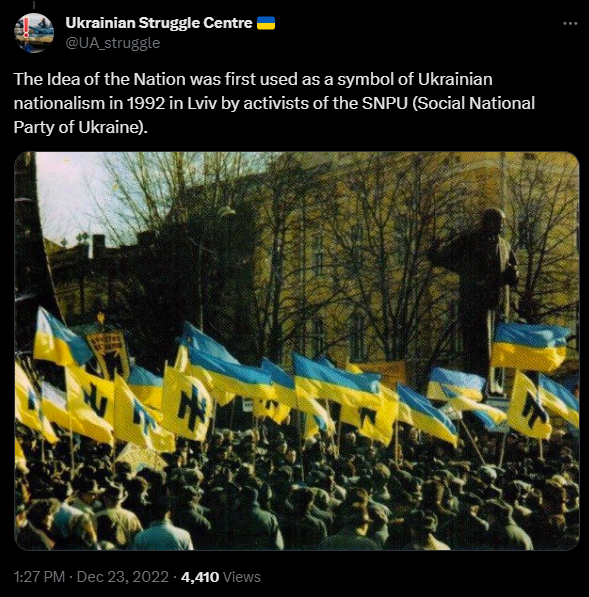
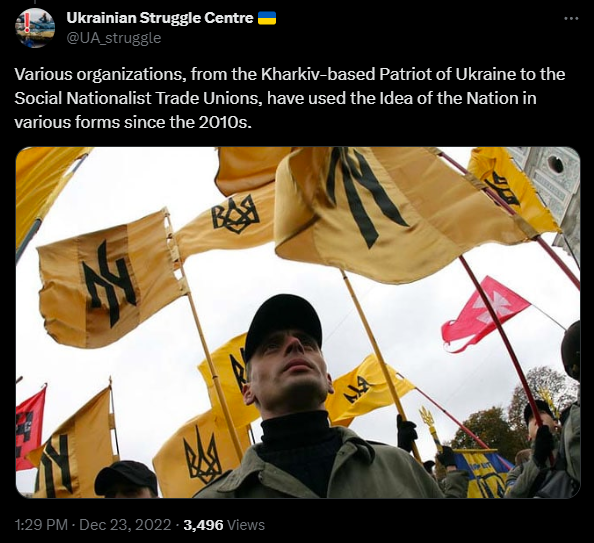
So while Azov’s defenders are claiming that these symbols are purely “historical”, “patriotic” logos with no ties to Nazism, the only sources that seem to feature them are Neo-Nazi groups, funny that.
It’s worth noting that the Wolfsangel does have a history before Nazism, quite a long running one in fact: The design is based on an Germanic old hunting tool, which is where its name, which translates to “Wolfs Hook” in English, comes from, and the symbol is actually still used in Germanic heraldry to this day.
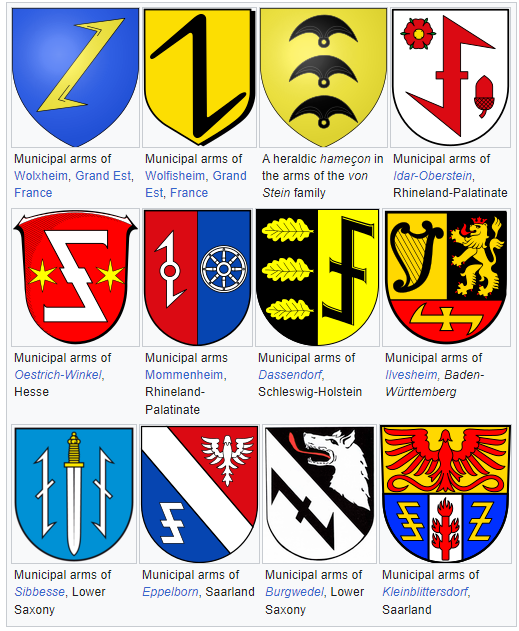 https://en.wikipedia.org/wiki/Wolfsangel
https://en.wikipedia.org/wiki/Wolfsangel
But when we see the symbol being used in Ukraine by these far-right groups, the inspiration is obviously quite different, it’s the same sort of contrast as seeing a Swastika in a Hindu temple vs seeing one used at a Neo-Nazi rally, one really is a marker of ancient history, the other is a sign of Nazism, when we consider the Neo-Nazi background of the “Social-Nationalists”, it becomes quite clear what side the “National Idea” is on.
An Azov linked magazine aptly named the “Black Sun” also offered similar denials about that symbol too, claiming that the Black Sun was a sacred old Ukrainian symbol which had no hint of “hostile ideologies” behind it.
But this denial is even less credible than Azov’s explanations for the Wolfsangel, while the Wolfsangel does actually have an old historical background to it, separated from Nazism, the specific design of the Black Sun Azov made use of does not.
While there are older symbols that resemble the Black Sun, this specific Black Sun design originated from Himmler’s castle, and its name has an even deeper Nazi history.
The “Black Sun” name was coined by an occultist esoteric Nazi group known as “the Landig Group”, formed by former SS officer Wilhelm Landig, the Landig Group promoted baffling cult theories about a secret Aryan society that had their own UFOs, and they established the Black Sun, which they saw as a symbol possessing a mystic replenishing energy for the Aryan race, a replacement for the original swastika.
And when you look closer at the design, it’s easy to see why, the Black Sun actually contains 2 of the most recognised logos of Nazism in its design, it includes 3 instances of the Swastika and these Swastikas are visualised by 12 of what the Nazis called “Siegrunes”, the same runes that make up the SS “lightning bolt” logo, so it’s a very open use of Nazi symbolism, but the “wheel” design obscures this, its true meaning hidden in plain sight.
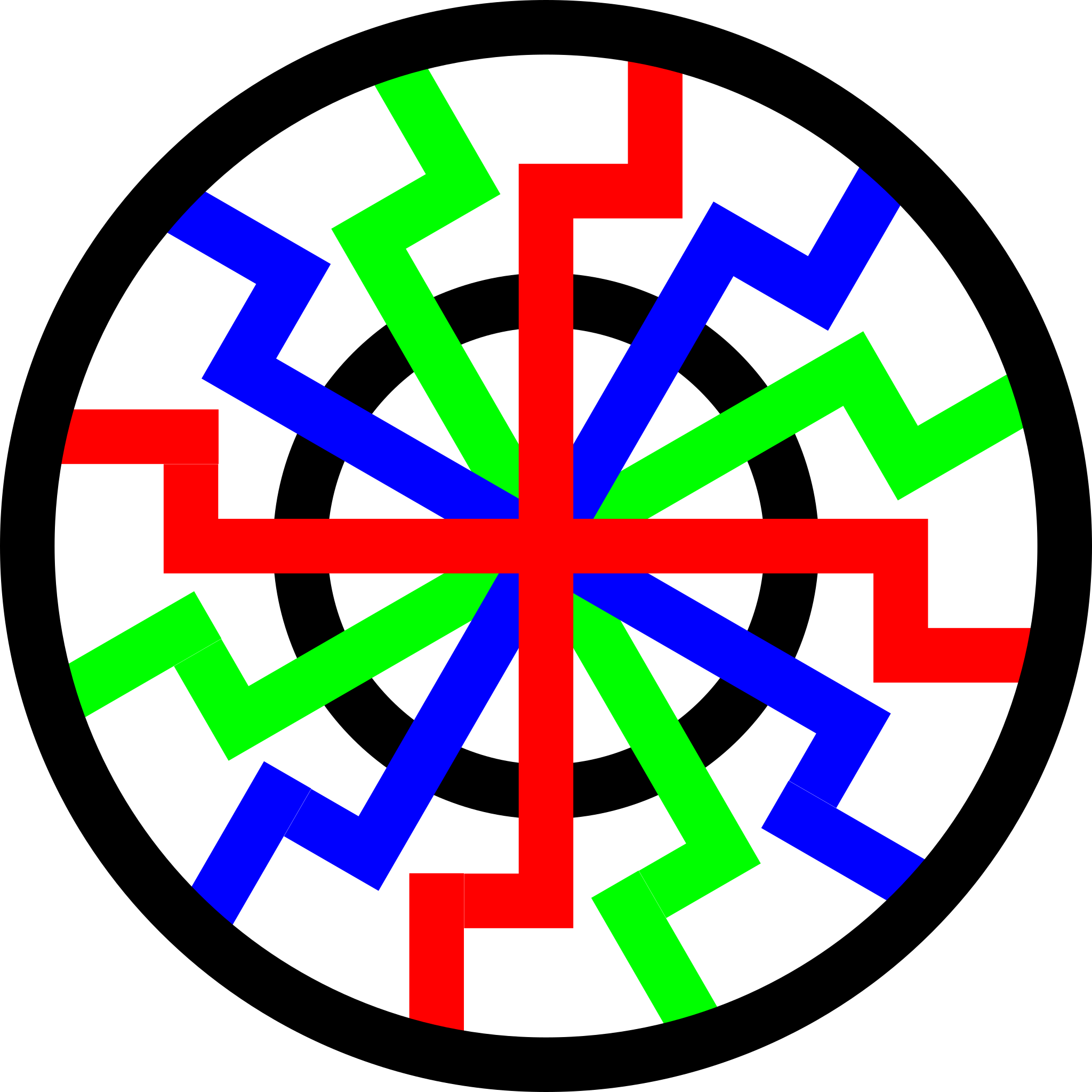 Attribution: Ratatosk / derivative work: Viciarg Licence: CC-BY-SA DE
Attribution: Ratatosk / derivative work: Viciarg Licence: CC-BY-SA DE
If this sounds hard to believe, which it would since it’s batshit insane, Azov were even more on the nose about this than you might expect, the Battalion had its own Engineering Corps formed in May 2014, and the patch for this corps included a Black Sun with a UFO on top, and a Wolfsangel in its centre.
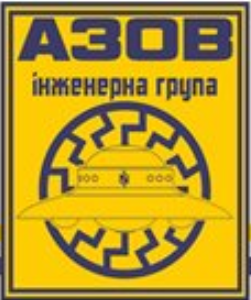
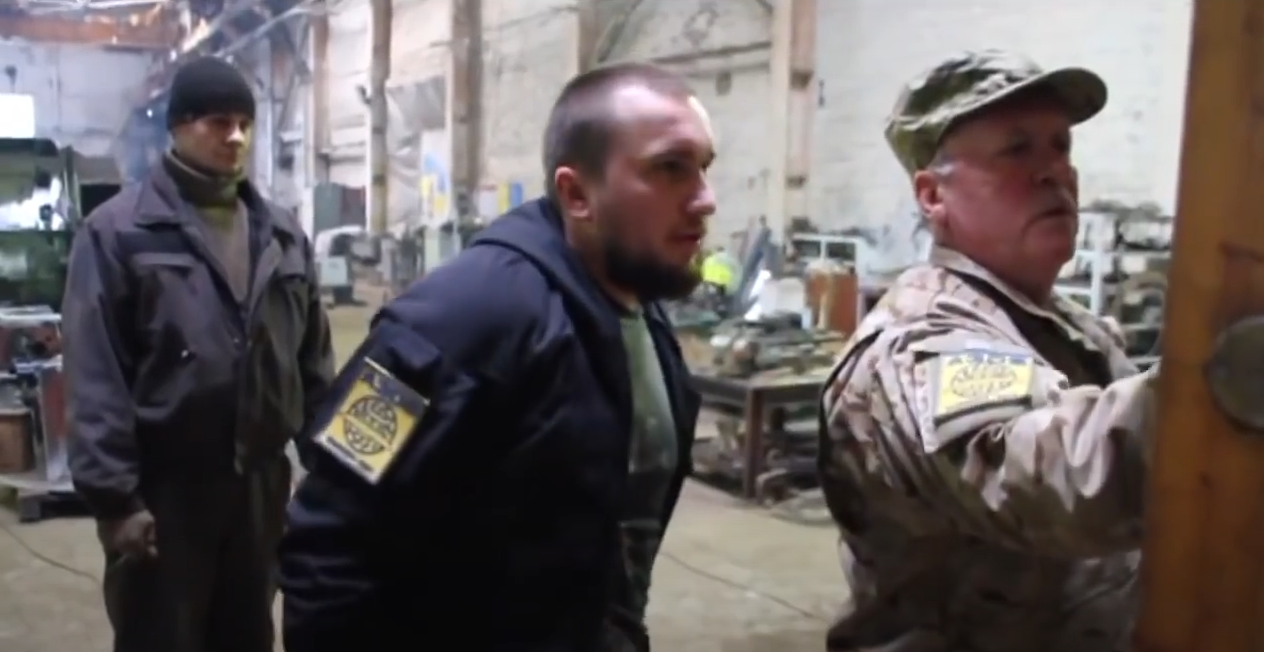 https://www.youtube.com/watch?v=GAC6LmNlgVE
https://www.youtube.com/watch?v=GAC6LmNlgVE
Does that mean that Azov is in on the Landig UFO cult? Probably not, the Black Sun has now become a general Neo Nazi symbol that isn’t so tied to Landig’s claims anymore, it’s often used because there’s less awareness on its meaning from the general public: The Black Sun isn’t something the average person immediately associates with Nazism, unlike say the Swastika, which is ironic given that the Swastika has a long pre-Nazi history going back thousands of years while the Black Sun was specifically a product of Nazism.
The UFO Black Sun is a perfect example of this obscurity, it can essentially be looked at as an in-joke, using an icon steeped in obscure Nazi conspiracy theories that almost no one will recognise.
Even the original name of Azov, the Black Corps, seems to be a veiled Nazi reference, during the Nazi era the SS had their own newspaper which was distributed to its membership, and guess what that was called? Das Schwarze Korps - The Black Corps. Could this be a coincidence? Sure, but given Azov’s constant references to SS designs and mythology in their symbolism, that name was probably a very conscious choice on Biletsky’s part.
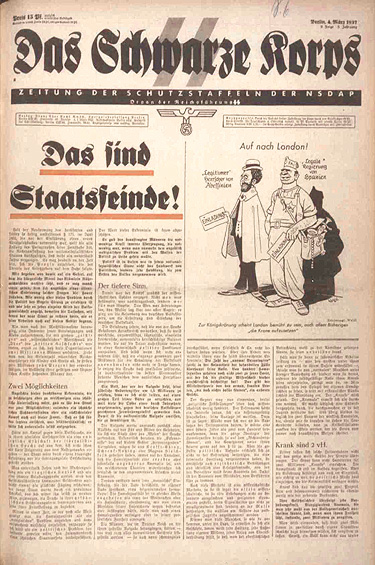
Despite Azov and its defenders being rather obviously unreliable narrators, wearing Nazi symbols on their sleeves while pretending not to notice, the Battalion’s leanings were overlooked by the Ukrainian government because they were a valuable asset on the battlefield, in fact Azov was allowed to significantly expand over time, joining the Ukrainian National Guard as the “Azov Regiment” in November 2014 and later reforming into the “Azov Brigade” in 2023.
Ukraine’s continued acceptance of Neo-Nazis in their armed forces was a sore spot, leading to damaging articles in the West and powerful propaganda from Russia, but rather than countering this by admitting the problems many Ukrainians instead resorted to more unconvincing denials which were then imitated by sympathisers of Ukraine in the West.
Take for example this article from Ukrainian outlet “Euromaidan Press”, which claims that Azov is simply just another unit of Ukraine’s military and not a Neo Nazi force, insisting that there are no units with any ideology in Ukraine’s forces, or this article from Forbes which claims that Azov has “deradicalised” and that early extremist leaders like Biletsky and his “pseudo-pagan” symbols are gone.
And these claims simply don’t match reality, while Biletsky stepped down as the commander of Azov shortly after it became a Battalion, moving his focus towards forming a new political movement called the “Azov Civil Corps” (which later became a political party called the “National Corps”), the commanders who succeeded him as the head of Azov were also Biletsky affiliates:
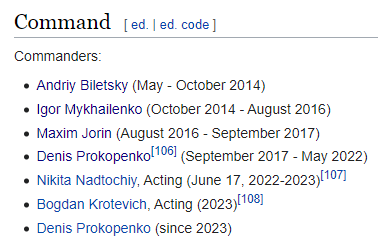
The 2nd commander of the Regiment, in charge between 2014 to 2016, was Senior lieutenant Igor Mykhailenko, a former member of Patriot of Ukraine, who went on to join the National Corps.
And this isn’t some well hidden secret either, we got the details about these commanders from Ukrainian language Wikipedia, which cites public news sources, in the case of Maxim Jorin one of the sources is an interview with the man himself, where his ties to both Azov and National Corps are mentioned by name in the first 2 lines of the article.
So what about Azov’s leadership after 2017? Did it all become peachy clean after that? I’m sure absolutely none of you will be surprised by the answer, which is no.
Azov’s commander since 2017 (except for a period between May 2022 and July 2023 when he was held prisoner), is Lieutenant Colonel Denys Propenko, and we found an article from an outlet called The Nation that, among other things, delves into his history.
Put simply, the article notes that Propenko isn’t new blood, having been with Azov since its beginning, it also mentions that he comes from a football hooligan group called the “White Boys Club”, known for their habit of posting Neo Nazi symbolism on their socials, the outlet further explains that Propenko’s deputy, Svyatoslav Palamar, was affiliated with Patriot of Ukraine. Remember, these are supposed to be Azov’s “moderate” new leaders.
While Propenko and his subordinates aren’t members of the National Corps as far as we know, they and Azov as a whole are making no effort to hide their continued affiliation with Andriy Biletsky.
Azov’s official YouTube channel is still displaying Black Sun and Wolfsangel logos, and showcasing Biletsky at Azov rallies in uniform alongside soldiers brandishing Wolfsangel and Black Sun shields, on this channel you can also find clips showing figures with swastika tattoos that they only sometimes even bother to try and hide.
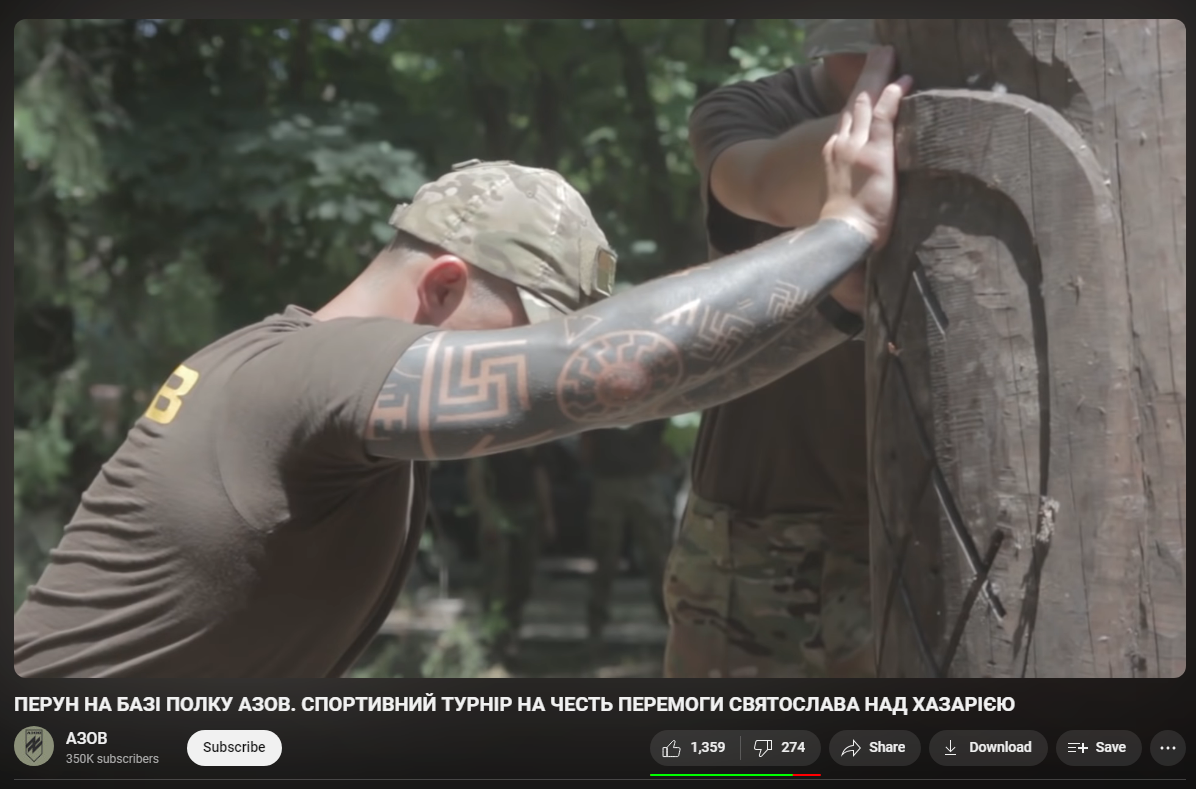
And in these videos here, Biletsky can be seen side by side in uniform with Propenko, with the unit’s troops once again displaying their Black Sun shields at a torchlit rally.
The fact that Azov’s own social media has proudly, publicly displayed its soldiers still identifying with Neo Nazi symbolism, and its leaders standing side by side with its far-right founder, shows that the suggestion Azov Brigade has cut ties with its radical past is laughable; The background of its “new management” makes that point even more obvious.
And even the Ukrainian government is aware of this, back in 2019 Ukraine’s then interior minister Arsen Avakov publicly stated that he was meeting with Biletsky about the Regiment and that Biletsky had provided Azov with “substantial support”, and in an article for the Atlantic Council think tank bluntly titled “The Azov Regiment has not depoliticized” researcher Oleksiy Kuzmenko cited several instances of Azov figures crediting Biletsky for the unit’s survival.
These factors are something leaders in the West are aware of, despite what is said publicly, as far back as 2015 the US House of Representatives unanimously agreed to block US aid money from going to Azov, in 2018 Congress imposed an arms ban on the group and the State Department labelled National Corps as a hate group, citing their actions against Roma minorities and warning about a growing trend of hate groups carrying out attacks on ethnic and sexual minorities, feminists, and generally anyone else they considered to be “non” or “anti” Ukrainian.
Even in 2022, with US aid to Ukraine at its height, Congress still included a provision specifically blocking aid from going to Azov in their 13 billion dollar support package for Ukraine.
 https://www.congress.gov/bill/117th-congress/house-bill/2471/text
https://www.congress.gov/bill/117th-congress/house-bill/2471/text
As we can see, there are countless examples of Azov and the National Corps having a continued crossover, anyone who bothers to do the research can see how much of an obvious lie this “deradicalisation” narrative is, when downplaying their ideology doesn’t work, denialists still have a few remaining lines of defence:
First is the classic whataboutism: “Other countries have Nazis in the military too!”
Through & clarifying BBC historical analysis of Nazism in #Ukraine, including Azov Brigade.
— Gina InTheBurg 🇺🇦🌻🥥🌴 (@GinaInTheBurg) November 21, 2022
Conclusion: it's no more & poss less of a problem than in other countries.
Even the US has Nazis & White Supremacists in its military:https://t.co/llV8DQ6fSdhttps://t.co/BIQ4z1yc0b https://t.co/w8VvAoL1sA
And yes, that’s true, Neo-Nazis are by nature militaristic, and so they will always have a desire to infiltrate militaries to learn tactics and gain experience, we know this has happened before, but Azov is different.
When we usually see Nazi infiltration of the military, we’re talking about individuals or small groups of Nazis joining existing units, and keeping their views to a select group in the know, and when they get caught organising, something is done about it, for example in 2018 a British Army soldier was jailed for recruiting for the Neo-Nazi terror group National Action, he wasn’t allowed to get off lightly, he was convicted and jailed.
With the Azov Brigade, a Neo-Nazi group got to form their own unit as a collective, publicly displaying their ideology in their symbolism, with the Ukrainian government not only refusing to take action against this, but actively covering for and legitimising the group, for whatever deficiencies there are in Anti-Extremist approaches in other militaries, you would not be able to form a National Action Battalion in the UK, you would end up in prison, not on a pedestal as a “hero”.
Second, “since they’re Nazis, don’t you want them to go and fight so that they’ll die in the war?”, this is a point notably used by popular YouTuber Adam Something, who coupled it with “what else was Ukraine supposed to do but accept the ultranationalists, when no one else would fight?” as another defence.
The obvious answer is, yes, some Nazis who participate in the war will die, it’s a war, but what else happens in war? Soldiers survive, and when they survive they come home, with all the experiences and life lessons the war gave them, that’s not something you want far-right, racialist, authoritarian militants to come back with.
As for what Ukraine was supposed to do, don’t empower Neo-Nazis with their own separate military unit that they control, this is pretty obvious. While the Azovites have developed a reputation for good fighting, they are far from the only volunteer movement that emerged during the Euromaidan or the Donbas War, plenty more people went to bat for Ukraine than obscure Fascists, empowering literal Neo Nazis with martial authority isn’t a good idea, which is why most countries don’t do that, if we look at our jailed National Action activist as an example, he was considered an “outstanding soldier”, but he still ended up in prison when his Nazi recruitment was uncovered.
Another truly baffling explanation we’ve heard for Azov is “free speech”. Yes, free speech. Azov was integrated into the Ukrainian military because the Ukrainian constitution gives its people a right to freedom of speech, that is a genuine argument we’ve heard to justify the acceptance of Azov, it was made by Pro-Ukraine analyst Ryan McBeth.
And, well, this one doesn’t really need much work to address, there’s a massive difference between being allowed to express your opinion and being allowed to have your own private army, which is why despite the US having some of the most entrenched freedom of speech protections in the world with its First Amendment, it doesn’t have its own Neo-Nazi units like Azov.
The last line of defence we’ve found is also the most recent one, simply denying the group’s history entirely.
Remember the US ban on aid to Azov? In June 2024 it was revoked, a State Department spokesperson told the BBC this was because they had found no evidence of human rights violations by Azov and that “Russian disinformation attempts to conflate Ukraine’s National Guard Unit of 12th Special Forces Brigade Azov with a militia formed to defend Ukraine against Russia’s invasion in 2014, called the ‘Azov Battalion’,“.
The State Department should probably do a basic Google search then and check out the Azov Brigade’s Wikipedia page:
What they said was a blatantly obvious lie, although the structure and people changed overtime, the Azov Brigade is the organisation that started as the Black Corps, then became the Azov Battalion, then the Azov Regiment, then the Azov Brigade, there’s a straight line connecting them.
This is not “Russian disinformation”, it’s not misinformation, it’s not misleading in any way, it’s a historical fact, yet the BBC article reporting this simply included the official’s comments with no questions or pushback at all, it also stated that “The current leadership of the Azov brigade says its members have no ties to far-right organisations or any other extremist groups - a claim that has not been independently verified.”
Why is it that they made no attempt to independently verify that claim? We can guess, because they know what they would find if they did, and it wouldn’t look pretty for Azov.
We could go over more and more instances of denialism, but at some point we just have to say, you get the picture. This whitewashing just doesn’t hold up to scrutiny, yet it persists because Western governments and mainstream media outlets have repeated it over and over and over again for years, and because most people haven’t done their own research they don’t know better.
I would be lying if I said I was shocked by this, I’m not, to be shocked would imply I expected better, but the fact that so many in the media have been willing to repeat and turn a blind eye to the most blatant of falsehoods for cynical geopolitical reasons should be a stain on their record for a long time to come.